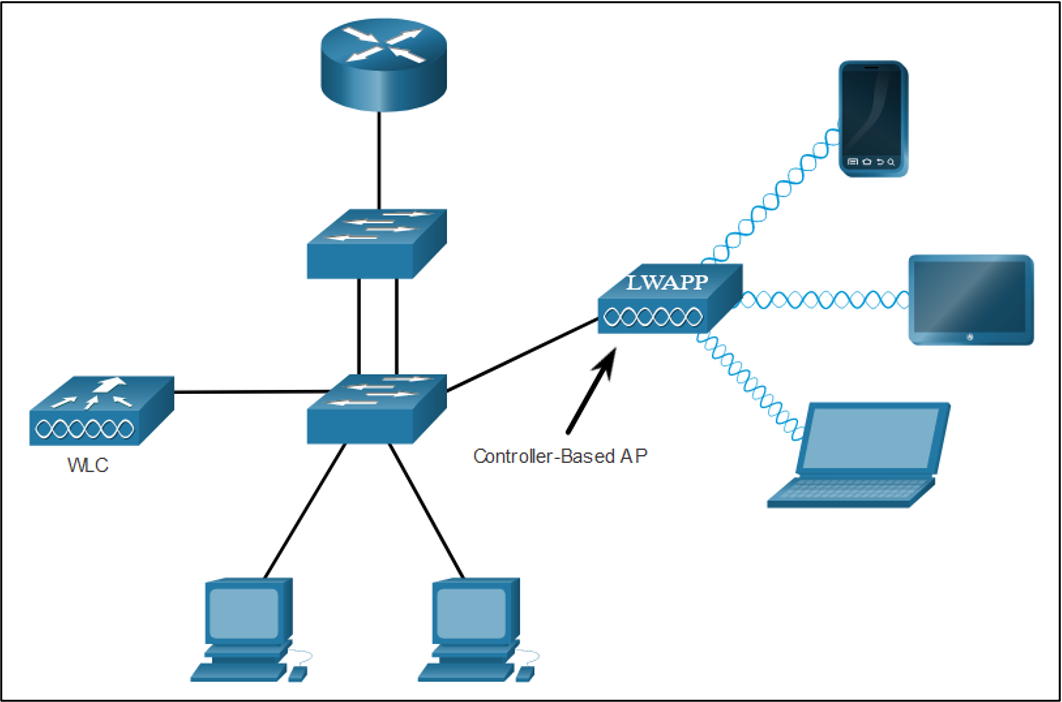
WLAN Concepts
Module Objective: Explain how WLANs enable network connectivity.
| Topic Title | Topic Objective |
|---|---|
| Introduction to Wireless | Describe WLAN technology and standards. |
| Components of WLANs | Describe the components of a WLAN infrastructure. |
| WLAN Operation | Explain how wireless technology enables WLAN operation. |
| CAPWAP Operation | Explain how a WLC uses CAPWAP to manage multiple APs. |
| Channel Management | Describe channel management in a WLAN. |
| WLAN Threats | Describe threats to WLANs. |
| Secure WLANs | Describe WLAN security mechanisms. |
12.1 Introduction to Wireless
Benefits of Wireless
- A Wireless LAN (WLAN) is a type of wireless network that is commonly used in homes, offices, and campus environments.
- WLANs make mobility possible within the home and business environments.
- Wireless infrastructures adapt to rapidly changing needs and technologies.

Types of Wireless Networks
- Wireless Personal-Area Network (WPAN) – Low power and short-range (20-30ft or 6-9 meters). Based on IEEE 802.15 standard and 2.4 GHz frequency. Bluetooth and Zigbee are WPAN examples.
- Wireless LAN (WLAN) – Medium sized networks up to about 300 feet. Based on IEEE 802.11 standard and 2.4 or 5.0 GHz frequency.
- Wireless MAN (WMAN) – Large geographic area such as city or district. Uses specific licensed frequencies.
- Wireless WAN (WWAN) – Extensive geographic area for national or global communication. Uses specific licensed frequencies.
Wireless Technologies
Bluetooth – IEEE WPAN standard used for device pairing at up to 300ft (100m) distance.
- Bluetooth Low Energy (BLE) – Supports mesh topology to large scale network devices.
- Bluetooth Basic Rate/Enhanced Rate (BR/EDR) – Supports point-to-point topologies and is optimized for audio streaming.
WiMAX (Worldwide Interoperability for Microwave Access) – Alternative broadband wired internet connections. IEEE 802.16 WLAN standard for up 30 miles (50 km). Cellular Broadband – Carry both voice and data. Used by phones, automobiles, tablets, and laptops.
- Global System of Mobile (GSM) – Internationally recognized
- Code Division Multiple Access (CDMA) – Primarily used on the US.
Satellite Broadband – Uses directional satellite dish aligned with satellite in geostationary orbit. Needs clear line of site. Typically used in rural locations where cable and DSL are unavailable.
802.11 Standards
802.11 WLAN standards define how radio frequencies are used for wireless links.
| IEEE Standard | Radio Frequency | Description |
|---|---|---|
| 802.11 | 2.4 GHz | Data rates up to 2 Mb/s |
| 802.11a | 5 GHz | Data rates up to 54 Mb/s Not interoperable with 802.11b or 802.11g |
| 802.11b | 2.4 GHz | Data rates up to 11 Mb/s Longer range than 802.11a and better able to penetrate building structures |
| 802.11g | 2.4 GHz | Data rates up to 54 Mb/s Backward compatible with 802.11b |
| 802.11n | 2.4 and 5 GHz | Data rates 150 – 600 Mb/s Require multiple antennas with MIMO technology |
| 802.11ac | 5 GHz | Data rates 450 Mb/s – 1.3 Gb/s Supports up to eight antennas |
| 802.11ax | 2.4 and 5 GHz | High-Efficiency Wireless (HEW) Capable of using 1 GHz and 7 GHz frequencies |
Radio Frequencies
All wireless devices operate in the range of the electromagnetic spectrum. WLAN networks operate in the 2.4 and 5 GHz frequency bands.
- 2.4 GHz (UHF) – 802.11b/g/n/ax
- 5 GHz (SHF) – 802.11a/n/ac/ax
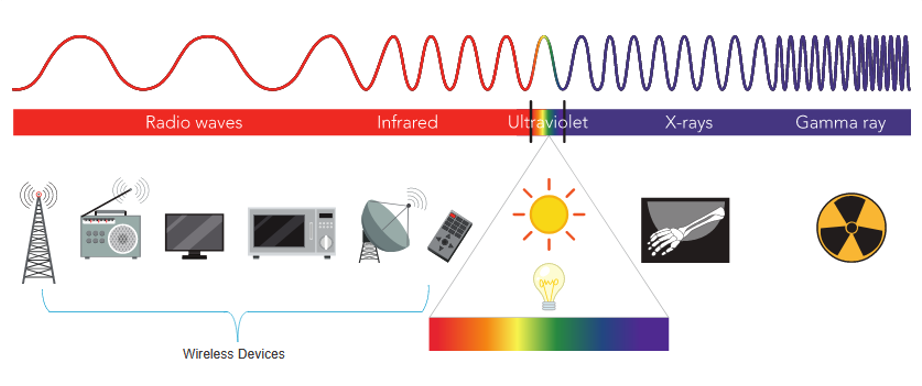
Wireless Standards Organizations
Standards ensure interoperability between devices that are made by different manufacturers. Internationally, the three organizations influencing WLAN standards:
- International Telecommunication Union (ITU) – Regulates the allocation of radio spectrum and satellite orbits.
- Institute of Electrical and Electronics Engineers (IEEE) – Specifies how a radio frequency is modulated to carry information. Maintains the standards for local and metropolitan area networks (MAN) with the IEEE 802 LAN/MAN family of standards.
- Wi-Fi Alliance – Promotes the growth and acceptance of WLANs. It is an association of vendors whose objective is to improve the interoperability of products that are based on the 802.11 standard
12.2 WLAN Components
Wireless NICs
To communicate wirelessly, laptops, tablets, smart phones, and even the latest automobiles include integrated wireless NICs that incorporate a radio transmitter/receiver. If a device does not have an integrated wireless NIC, then a USB wireless adapter can be used. 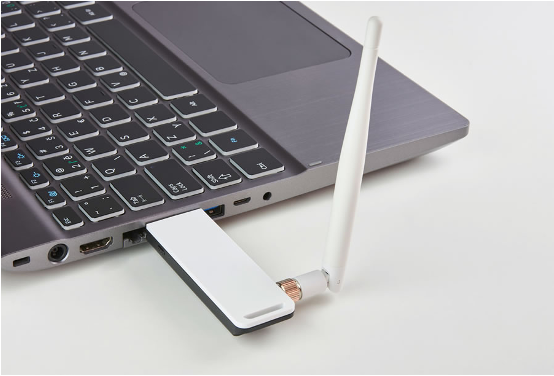
Wireless Home Router
A home user typically interconnects wireless devices using a small, wireless router. Wireless routers serve as the following:
- Access point – To provide wires access
- Switch – To interconnect wired devices
- Router – To provide a default gateway to other networks and the Internet
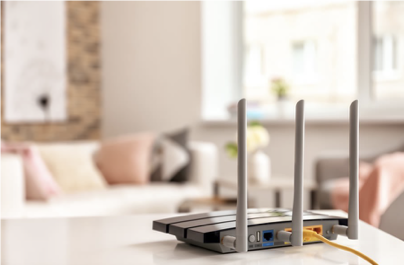
Wireless Access Point
Wireless clients use their wireless NIC to discover nearby access points (APs). Clients then attempt to associate and authenticate with an AP. After being authenticated, wireless users have access to network resources. 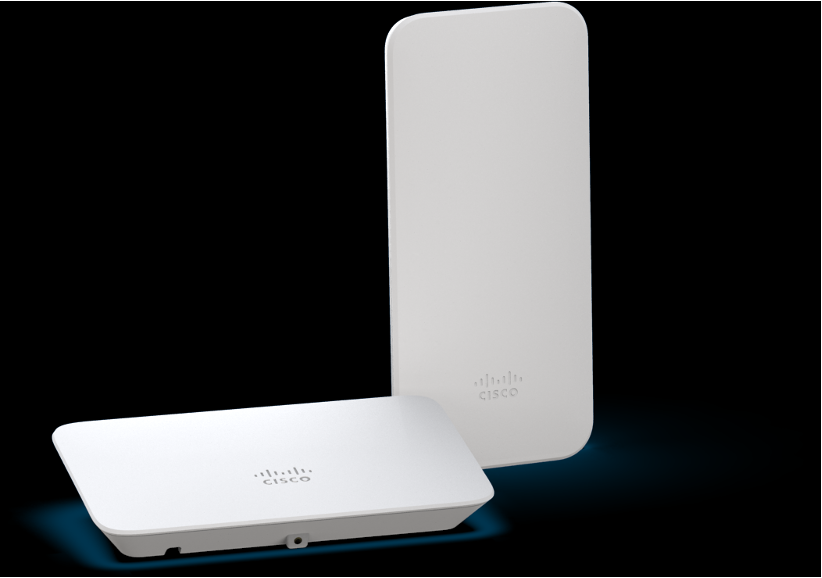
AP Categories
APs can be categorized as either autonomous APs or controller-based APs.
- Autonomous APs – Standalone devices configured through a command line interface or GUI. Each autonomous AP acts independently of the others and is configured and managed manually by an administrator.
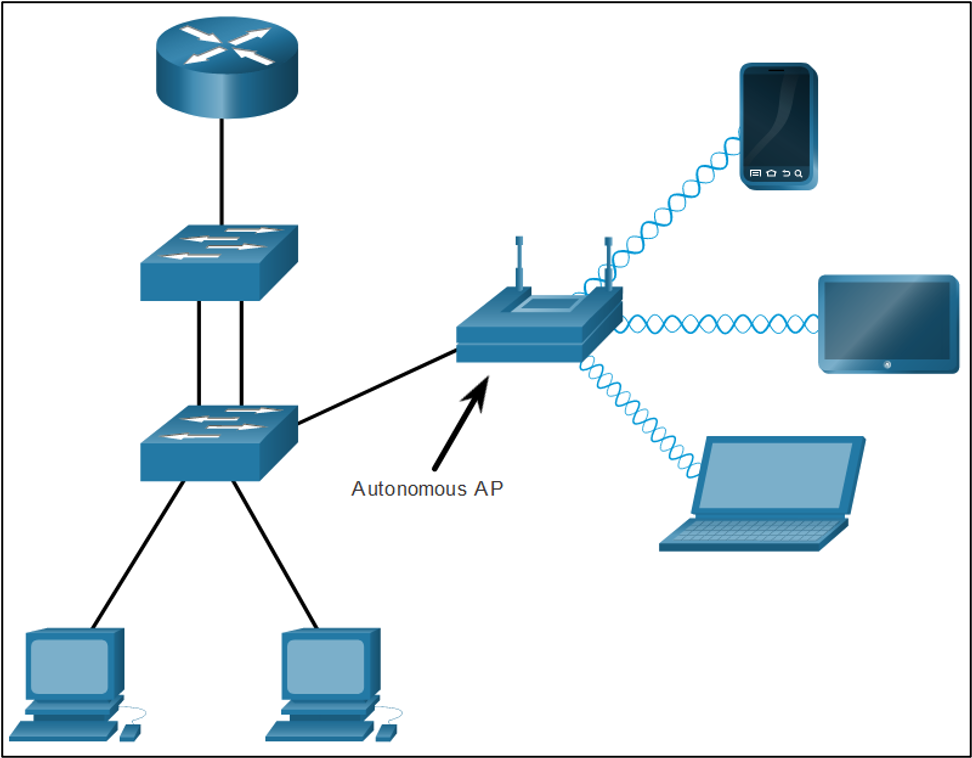
- Controller-based APs – Also known as lightweight APs (LAPs). Use Lightweight Access Point Protocol (LWAPP) to communicate with a LWAN controller (WLC). Each LAP is automatically configured and managed by the WLC.

Wireless Antennas
Types of external antennas:
- Omnidirectional – Provide 360-degree coverage. Ideal in houses and office areas.

- Directional – Focus the radio signal in a specific direction. Examples are the Yagi and parabolic dish.
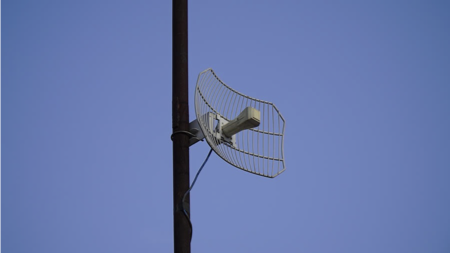
- Multiple Input Multiple Output (MIMO) – Uses multiple antennas (Up to eight) to increase bandwidth.

12.3 WLAN Operation
802.11 Wireless Topology Modes
Ad hoc mode – Used to connect clients in peer-to-peer manner without an AP.  Infrastructure mode – Used to connect clients to the network using an AP.
Infrastructure mode – Used to connect clients to the network using an AP.  Tethering – Variation of the ad hoc topology is when a smart phone or tablet with cellular data access is enabled to create a personal hotspot.
Tethering – Variation of the ad hoc topology is when a smart phone or tablet with cellular data access is enabled to create a personal hotspot. 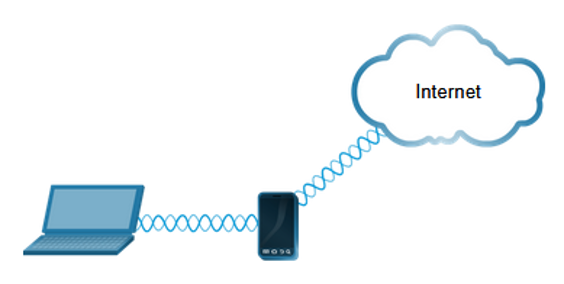
BSS and ESS
Infrastructure mode defines two topology blocks: Basic Service Set (BSS)
- Uses single AP to interconnect all associated wireless clients.
- Clients in different BSSs cannot communicate.
 Extended Service Set (ESS)
Extended Service Set (ESS)
- A union of two or more BSSs interconnected by a wired distribution system.
- Clients in each BSS can communication through the ESS.

802.11 Frame Structure
The 802.11 frame format is similar to the Ethernet frame format, except that it contains more fields. 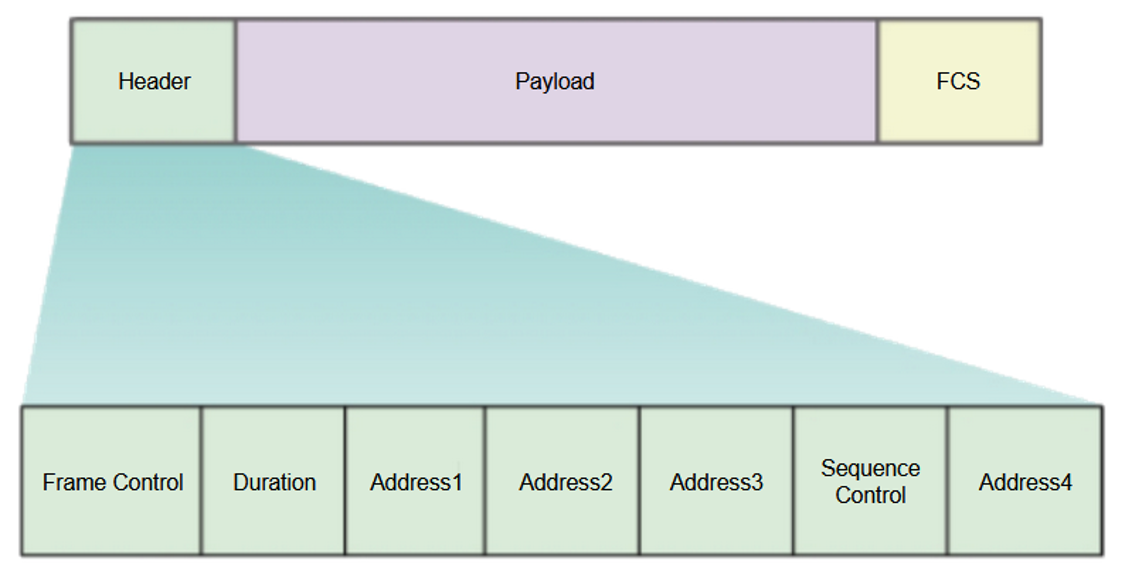
CSMA/CA
WLANs are half-duplex and a client cannot “hear” while it is sending, making it impossible to detect a collision. WLANs use carrier sense multiple access with collision avoidance (CSMA/CA) to determine how and when to send data. A wireless client does the following:
- Listens to the channel to see if it is idle, i.e. no other traffic currently on the channel.
- Sends a ready to send (RTS) message the AP to request dedicated access to the network.
- Receives a clear to send (CTS) message from the AP granting access to send.
- Waits a random amount of time before restarting the process if no CTS message received.
- Transmits the data.
- Acknowledges all transmissions. If a wireless client does not receive an acknowledgment, it assumes a collision occurred and restarts the process
Wireless Client and AP Association
For wireless devices to communicate over a network, they must first associate with an AP or wireless router.  Wireless devices complete the following three stage process:
Wireless devices complete the following three stage process:
- Discover a wireless AP
- Authenticate with the AP
- Associate with the AP
To achieve successful association, a wireless client and an AP must agree on specific parameters:
- SSID – The client needs to know the name of the network to connect.
- Password – This is required for the client to authenticate to the AP.
- Network mode – The 802.11 standard in use.
- Security mode – The security parameter settings, i.e. WEP, WPA, or WPA2.
- Channel settings – The frequency bands in use.
Passive and Active Discover Mode
Wireless clients connect to the AP using a passive or active scanning (probing) process.
- Passive mode – AP openly advertises its service by periodically sending broadcast beacon frames containing the SSID, supported standards, and security settings.

- Active mode – Wireless clients must know the name of the SSID. The wireless client initiates the process by broadcasting a probe request frame on multiple channels.
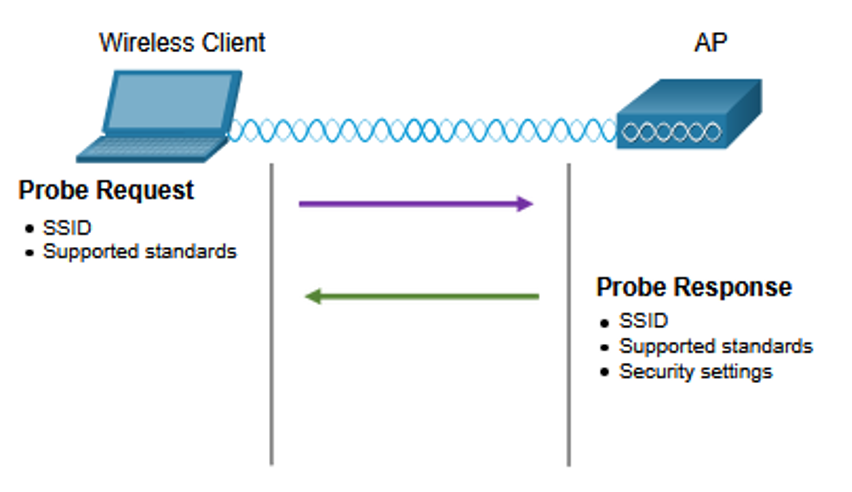
12.4 CAPWAP Operation
Introduction to CAPWAP
- CAPWAP is an IEEE standard protocol that enables a WLC to manage multiple APs and WLANs.
- Based on LWAPP but adds additional security with Datagram Transport Layer Security (DLTS).
- Encapsulates and forwards WLAN client traffic between an AP and a WLC over tunnels using UDP ports 5246 and 5247.
- Operates over both IPv4 and IPv6. IPv4 uses IP protocol 17 and IPv6 uses IP protocol 136.
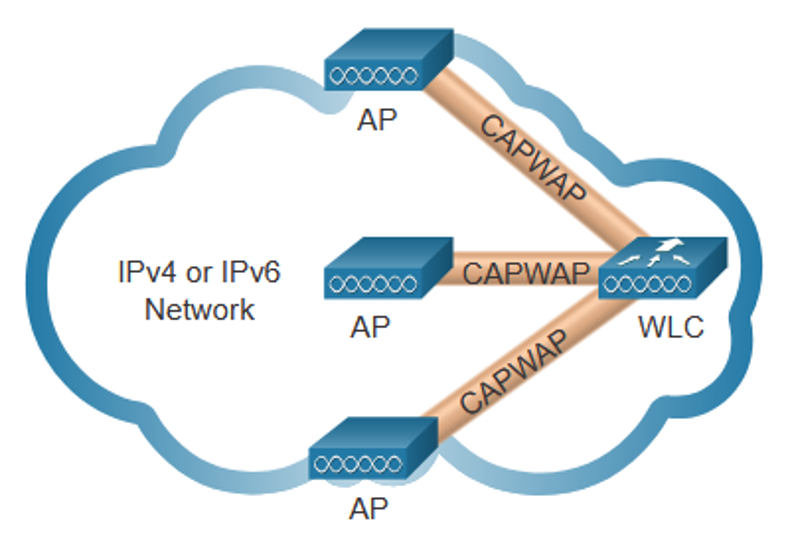
Split MAC Architecture ( MAC = Media Access Controller)
The CAPWAP split MAC concept does all the functions normally performed by individual APs and distributes them between two functional components:
- AP MAC Functions
- WLC MAC Functions
| Access Point (AP) MAC Functions | Wireless LAN Controller (WLC) MAC Functions |
|---|---|
| Beacons and probe responses | Beacons and probe responses |
| Authentication | Authentication |
| Packet acknowledgements and retransmissions | Packet acknowledgements and retransmissions |
| Association and re-association of roaming clients | Association and re-association of roaming clients |
| Frame queueing and packet prioritization | Frame queueing and packet prioritization |
| Frame translation to other protocols | Frame translation to other protocols |
| MAC layer data encryption and decryption | MAC layer data encryption and decryption |
| Termination of 802.11 traffic on a wired interface | Termination of 802.11 traffic on a wired interface |
DTLS Encryption
- DTLS provides security between the AP and the WLC.
- It is enabled by default to secure the CAPWAP control channel and encrypt all management and control traffic between AP and WLC.
- Data encryption is disabled by default and requires a DTLS license to be installed on the WLC before it can be enabled on the AP.

Flex Connect APs
FlexConnect enables the configuration and control of Aps over a WAN link. There are two modes of option for the FlexConnect AP:
- Connected mode – The WLC is reachable. The FlexConnect AP has CAPWAP connectivity with the WLC through the CAPWAP tunnel. The WLC performs all CAPWAP functions.
- Standalone mode – The WLC is unreachable. The FlexConnect AP has lost CAPWAP connectivity with the WLC. The FlexConnect AP can assume some of the WLC functions such as switching client data traffic locally and performing client authentication locally.
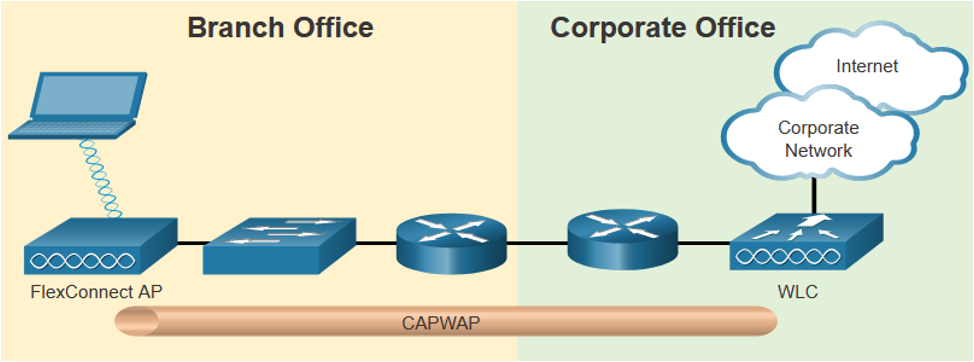
12.5 Channel Management
Frequency Channel Saturation
If the demand for a specific wireless channel is too high, the channel may become oversaturated, degrading the quality of the communication. Channel saturation can be mitigated using techniques that use the channels more efficiently.
- Direct-Sequence Spread Spectrum (DSSS) – A modulation technique designed to spread a signal over a larger frequency band. Used by 802.11b devices to avoid interference from other devices using the same 2.4 GHz frequency.
- Frequency-Hopping Spread Spectrum (FHSS) – Transmits radio signals by rapidly switching a carrier signal among many frequency channels. Sender and receiver must be synchronized to “know” which channel to jump to. Used by the original 802.11 standard.
- Orthogonal Frequency-Division Multiplexing (OFDM) – A subset of frequency division multiplexing in which a single channel uses multiple sub-channels on adjacent frequencies. OFDM is used by a number of communication systems including 802.11a/g/n/ac.
Channel Selection
- The 2.4 GHz band is subdivided into multiple channels each allotted 22 MHz bandwidth and separated from the next channel by 5 MHz.
- A best practice for 802.11b/g/n WLANs requiring multiple APs is to use non-overlapping channels such as 1, 6, and 11.
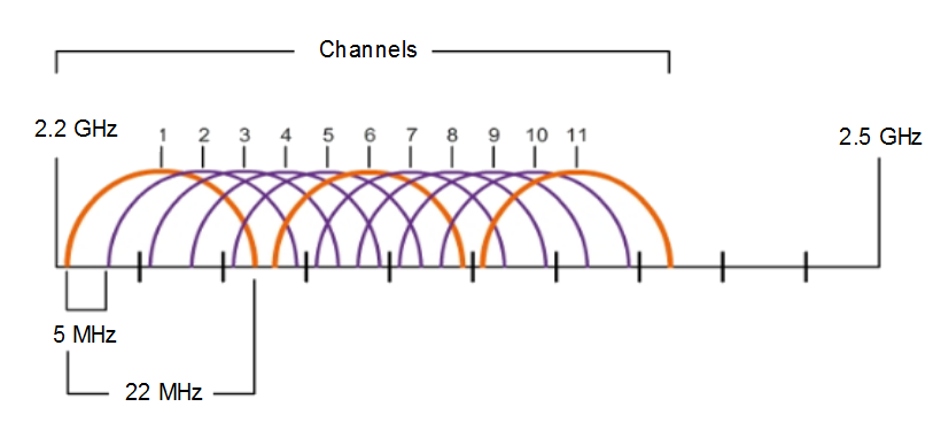
- For the 5GHz standards 802.11a/n/ac, there are 24 channels. Each channel is separated from the next channel by 20 MHz.
- Non-overlapping channels are 36, 48, and 60.
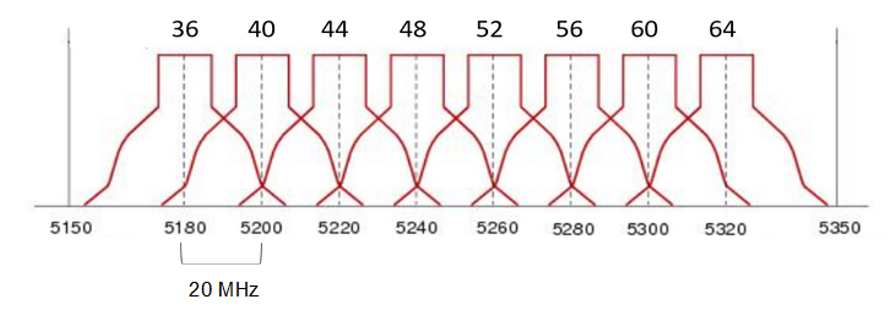
Plan a WLAN Deployment
The number of users supported by a WLAN depends on the following:
- The geographical layout of the facility
- The number of bodies and devices that can fit in a space
- The data rates users expect
- The use of non-overlapping channels by multiple APs and transmit power settings
When planning the location of APs, the approximate circular coverage area is important. 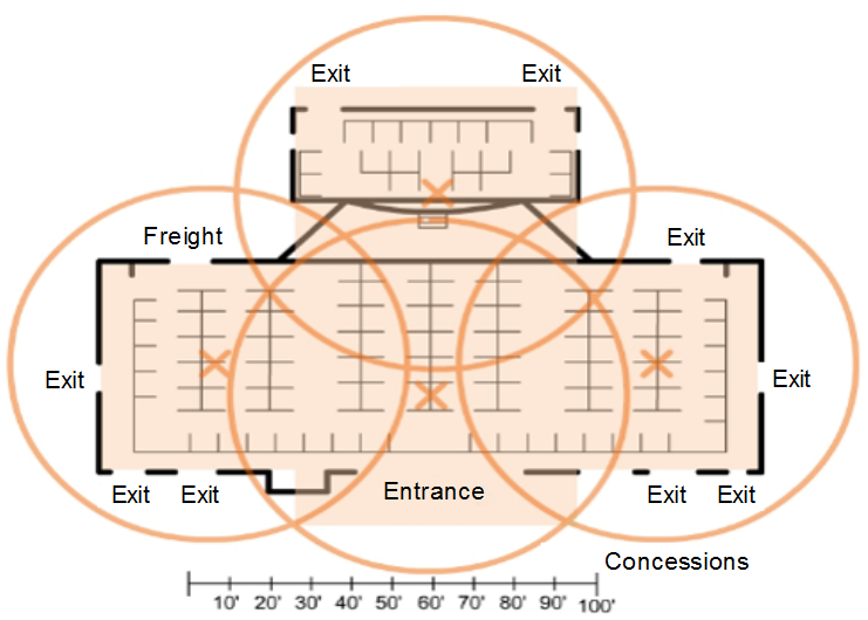
12.6 WLAN Threats
Wireless Security Overview
A WLAN is open to anyone within range of an AP and the appropriate credentials to associate to it. Attacks can be generated by outsiders, disgruntled employees, and even unintentionally by employees. Wireless networks are specifically susceptible to several threats, including the following:
- Interception of data
- Wireless intruders
- Denial of Service (DoS) Attacks
- Rogue APs
DoS Attacks
Wireless DoS attacks can be the result of the following:
- Improperly configured devices
- A malicious user intentionally interfering with the wireless communication
- Accidental interference
To minimize the risk of a DoS attack due to improperly configured devices and malicious attacks, harden all devices, keep passwords secure, create backups, and ensure that all configuration changes are incorporated off-hours.
Rogue Access Points
- A rogue AP is an AP or wireless router that has been connected to a corporate network without explicit authorization and against corporate policy.
- Once connected, the rogue AP can be used by an attacker to capture MAC addresses, capture data packets, gain access to network resources, or launch a man-in-the-middle attack.
- A personal network hotspot could also be used as a rogue AP. For example, a user with secure network access enables their authorized Windows host to become a Wi-Fi AP.
- To prevent the installation of rogue APs, organizations must configure WLCs with rogue AP policies and use monitoring software to actively monitor the radio spectrum for unauthorized APs.
Man-in-the-Middle Attack
- In a man-in-the-middle (MITM) attack, the hacker is positioned in between two legitimate entities in order to read or modify the data that passes between the two parties. A popular wireless MITM attack is called the “evil twin AP” attack, where an attacker introduces a rogue AP and configures it with the same SSID as a legitimate AP.
- Defeating a MITM attack begins with identifying legitimate devices on the WLAN. To do this, users must be authenticated. After all of the legitimate devices are known, the network can be monitored for abnormal devices or traffic.
12.7 Secure WLANs
SSID Cloaking and MAC Address Filtering
To address the threats of keeping wireless intruders out and protecting data, two early security features were used and are still available on most routers and APs:
- SSID Cloaking APs and some wireless routers allow the SSID beacon frame to be disabled. Wireless clients must be manually configured with the SSID to connect to the network.
- MAC Address Filtering An administrator can manually permit or deny clients wireless access based on their physical MAC hardware address. In the figure, the router is configured to permit two MAC addresses. Devices with different MAC addresses will not be able to join the 2.4GHz WLAN.
802.11 Original Authentication Methods
The best way to secure a wireless network is to use authentication and encryption systems. Two types of authentication were introduced with the original 802.11 standard: Open system authentication
- No password required. Typically used to provide free internet access in public areas like cafes, airports, and hotels.
- Client is responsible for providing security such as through a VPN.
Shared key authentication
- Provides mechanisms, such as WEP, WPA, WPA2, and WPA3 to authenticate and encrypt data between a wireless client and AP. However, the password must be pre-shared between both parties to connect.
Shared Key Authentication Methods
There are currently four shared key authentication techniques available, as shown in the table.
| Authentication Method | Description |
|---|---|
| Wired Equivalent Privacy (WEP) | The original 802.11 specification designed to secure the data using the Rivest Cipher 4 (RC4) encryption method with a static key. WEP is no longer recommended and should never be used. |
| Wi-Fi Protected Access (WPA) | A Wi-Fi Alliance standard that uses WEP but secures the data with the much stronger Temporal Key Integrity Protocol (TKIP) encryption algorithm. TKIP changes the key for each packet, making it much more difficult to hack. |
| WPA2 | It uses the Advanced Encryption Standard (AES) for encryption. AES is currently considered the strongest encryption protocol. |
| WPA3 | This is the next generation of Wi-Fi security. All WPA3-enabled devices use the latest security methods, disallow outdated legacy protocols, and require the use of Protected Management Frames (PMF). |
Authenticating a Home User
Home routers typically have two choices for authentication: WPA and WPA2, with WPA 2 having two authentication methods.
- Personal – Intended for home or small office networks, users authenticate using a pre-shared key (PSK). Wireless clients authenticate with the wireless router using a pre-shared password. No special authentication server is required.
- Enterprise – Intended for enterprise networks. Requires a Remote Authentication Dial-In User Service (RADIUS) authentication server. The device must be authenticated by the RADIUS server and then users must authenticate using 802.1X standard, which uses the Extensible Authentication Protocol (EAP) for authentication.
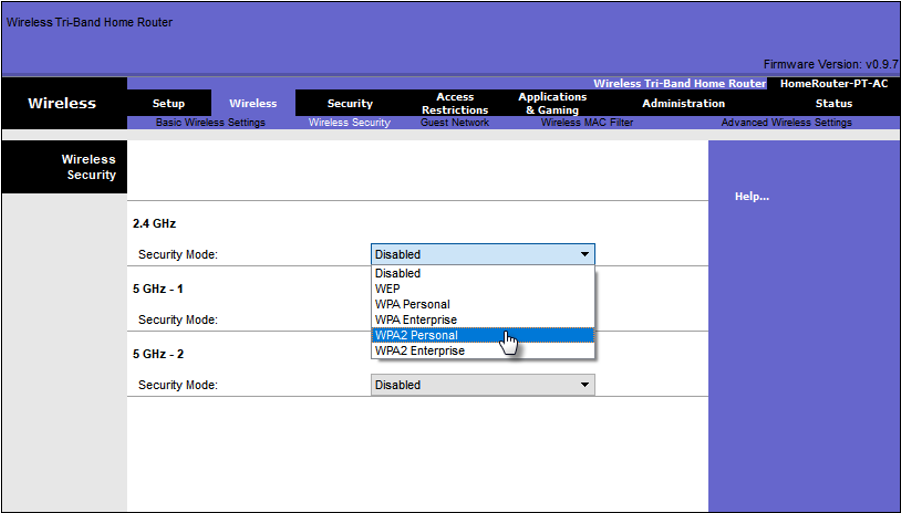
Encryption Methods
WPA and WPA2 include two encryption protocols:
- Temporal Key Integrity Protocol (TKIP) – Used by WPA and provides support for legacy WLAN equipment. Makes use of WEP but encrypts the Layer 2 payload using TKIP.
- Advanced Encryption Standard (AES) – Used by WPA2 and uses the Counter Cipher Mode with Block Chaining Message Authentication Code Protocol (CCMP) that allows destination hosts to recognize if the encrypted and non-encrypted bits have been altered.
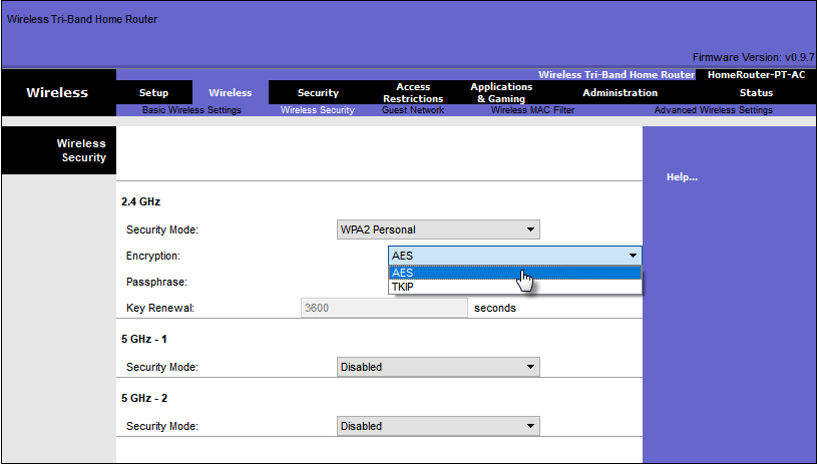
Authentication in the Enterprise
Enterprise security mode choice requires an Authentication, Authorization, and Accounting (AAA) RADIUS server. There pieces of information are required:
- RADIUS server IP address – IP address of the server.
- UDP port numbers –UDP ports 1812 for RADIUS Authentication, and 1813 for RADIUS Accounting, but can also operate using UDP ports 1645 and 1646.
- Shared key – Used to authenticate the AP with the RADIUS server.
 Note: User authentication and authorization is handled by the 802.1X standard, which provides a centralized, server-based authentication of end users.
Note: User authentication and authorization is handled by the 802.1X standard, which provides a centralized, server-based authentication of end users.
WPA 3
Because WPA2 is no longer considered secure, WPA3 is recommended when available. WPA3 Includes four features:
- WPA3 – Personal : Thwarts brute force attacks by using Simultaneous Authentication of Equals (SAE).
- WPA3 – Enterprise : Uses 802.1X/EAP authentication. However, it requires the use of a 192-bit cryptographic suite and eliminates the mixing of security protocols for previous 802.11 standards.
- Open Networks : Does not use any authentication. However, uses Opportunistic Wireless Encryption (OWE) to encrypt all wireless traffic.
- IoT Onboarding : Uses Device Provisioning Protocol (DPP) to quickly onboard IoT devices.